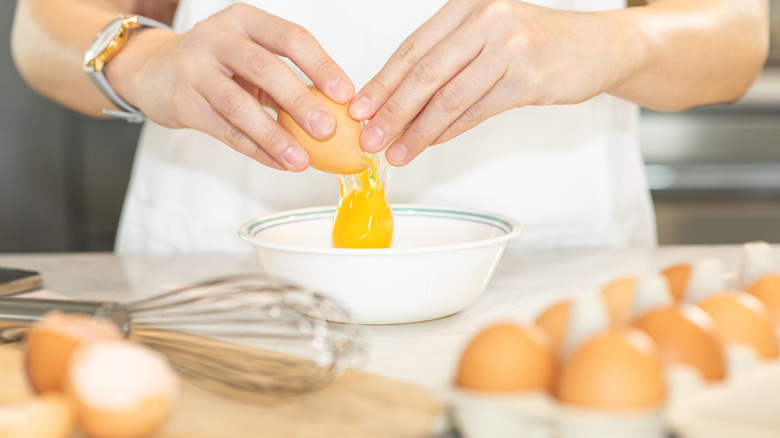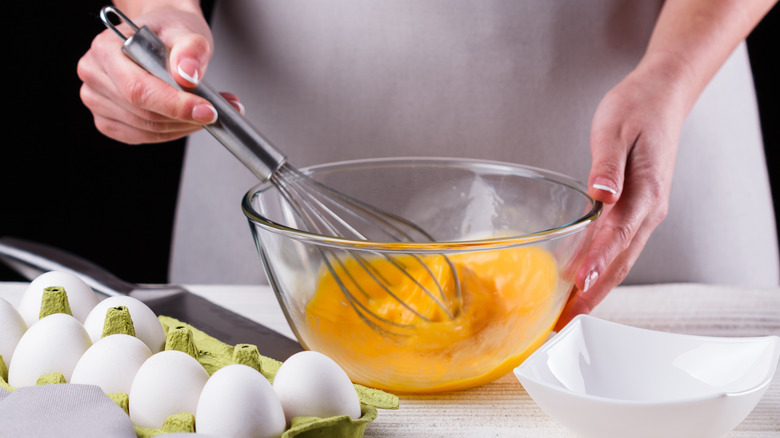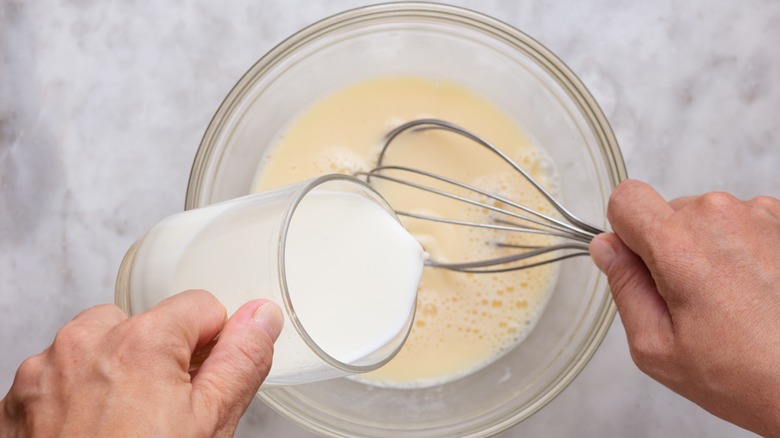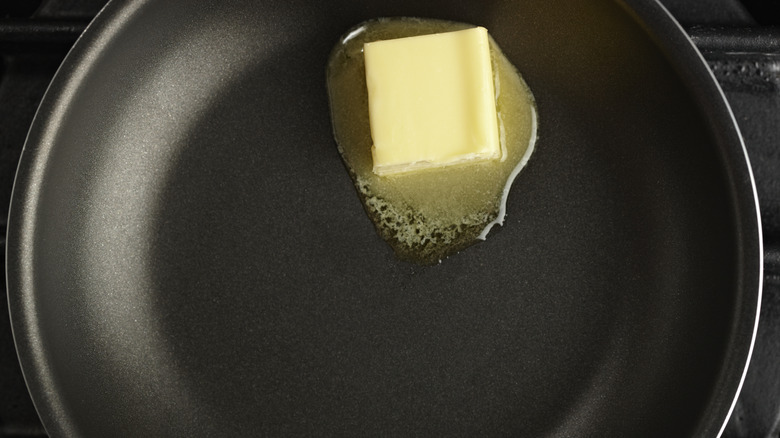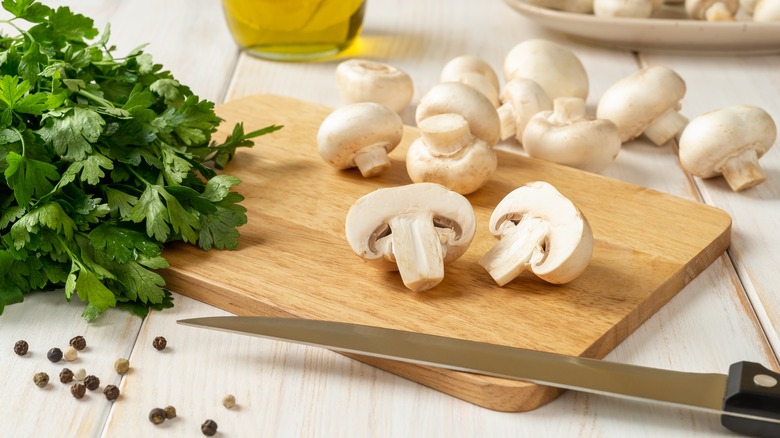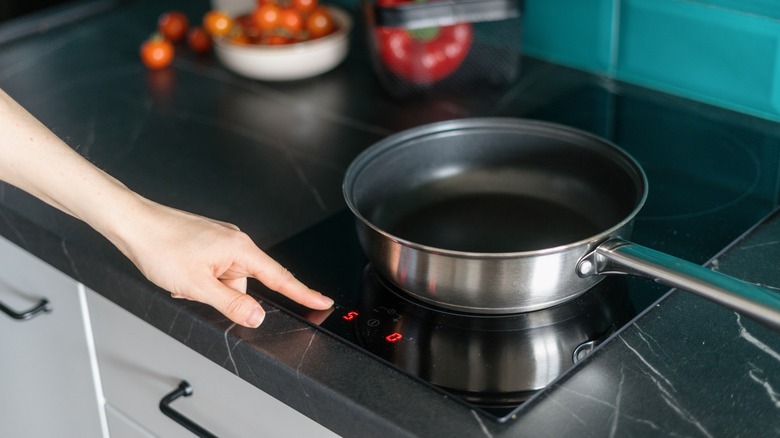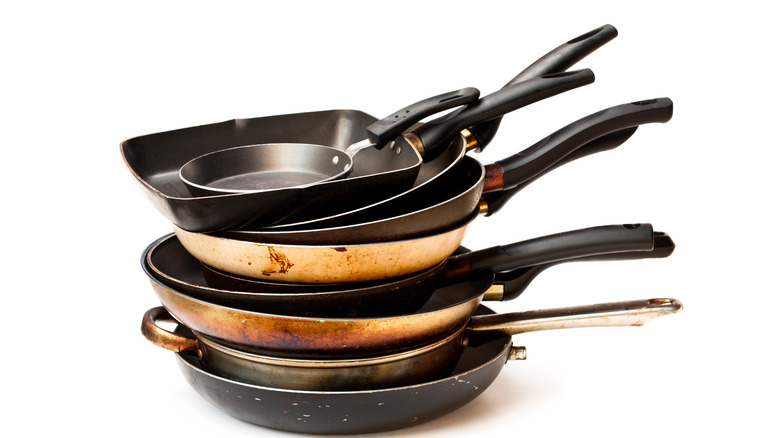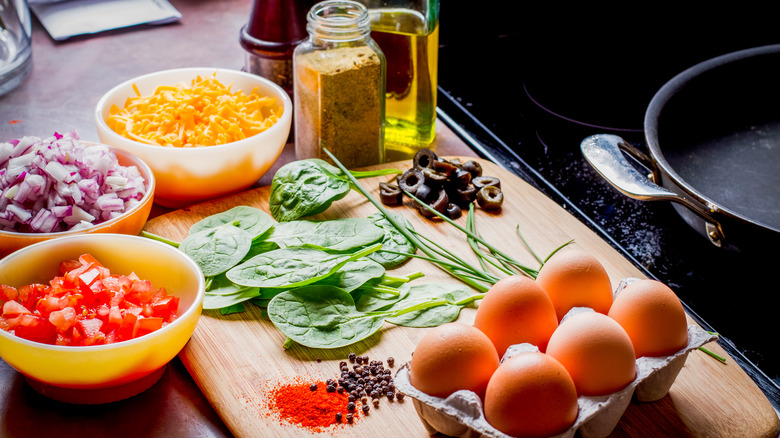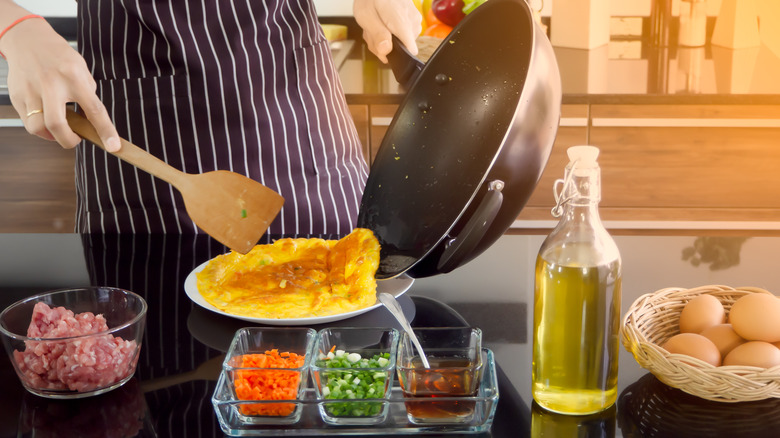15 Mistakes Everyone Makes When Cooking An Omelet, According To An Expert
For some, an omelet is their go-to daily breakfast. Others may only make omelets on the weekends or for special occasions. Regardless of whether you make omelets every day or only once in a while, you want the finished product to be as scrumptious and flavorful as possible. It should be cooked just right, have the right ratio of ingredients, and give your taste buds a reason to do a little happy dance the second you take a bite.
Unfortunately, making an omelet is not as simple as it seems, and several mistakes can prevent perfection. Nelson Serrano-Bahri, a chef and the Director of Innovation at the American Egg Board, explains some of these mistakes. From learning what to do with water-based ingredients to the perfect time for stuffing your creation, read on to discover what to avoid doing and some best practices before you start making your next omelet.
Not using fresh eggs
When preparing an omelet, you shouldn't reach for just any eggs. Nelson Serrano-Bahri advises staying away from eggs that have been hanging out for several weeks if you want to make the highest-quality and tastiest omelet. He explains, "When it comes to the eggs that you select for your omelet, fresher (under two weeks old) refrigerated shell eggs are recommended for optimal performance and functionality." This makes sense; fresher eggs will yield a fresher-tasting omelet.
If you need to make several omelets, however, Serrano-Bahri offers one alternative to save you from spending all of your prep time cracking dozens of eggs. He shares, "Liquid real egg products will work well, too, especially when cooking for a large crowd or buffet-style service." This way, you'll still be able to make a lot of scrumptious, crowd-pleasing omelets, but you won't have to rely on the egg powder that hotels use for their breakfast buffets.
Cracking eggs directly out of the fridge
Making an omelet involves some planning ahead. In addition to ensuring you have fresh enough eggs, you must leave yourself enough time to let the eggs come to room temperature before cracking them into a sieve or a mixing bowl. Nelson Serrano-Bahri cautions, "If you use cold eggs straight out of the refrigerator, it's hard to bring the eggs together when you are beating them." The last thing you want is for your eggs to remain separated; the finished omelet will taste less than perfect.
So, how early should you take the eggs out of the fridge? The precise answer will depend on how cold your fridge is and the temperature inside the kitchen. However, in most cases, the eggs should be ready after about half an hour. Just ensure you don't leave them out for more than the maximum of 2 hours. And, while we're discussing safety, don't forget that you also shouldn't wash store-bought eggs.
Overmixing the eggs
How long do you beat the eggs for when you make an omelet? If you find yourself whipping them with a whisk — or even a hand mixer — for several minutes, that's one mistake you've been making. Nelson Serrano-Bahri cautions against overmixing eggs. He explains that doing so, "especially with a hand mixer, can make them tough and dense."
Follow our expert's advice to avoid tough and dense omelets. "The key to a perfect omelet is to lightly beat your eggs until they are fluffy," explains Serrano-Bahri, adding you should "beat your eggs enough so they come together." Then, resist the urge to continue mixing. Once the eggs are light and fluffy, step away from the whisk and add the other ingredients you want. Your arm shouldn't feel sore after whisking your eggs. If it does, then you probably overmixed them.
Adding too much liquid
Nelson Serrano-Bahri cautions, "Don't add more than two tablespoons of liquid to your omelet mixture." If you overdo it with liquids, you're going to end up with a runny omelet, which no one is going to enjoy.
However, being cautious not to add too much liquid doesn't mean you can't add any. There are legitimate reasons to add water, milk, or other liquids to your omelet mixtures. Serrano-Bahri explains that you can "add water for volume and steam to help fluff your eggs up while cooking." Milk products, he notes, "will add fat and acidity and create a more tender omelet that can rip while cooking."
Forgetting the seasoning
Unless you want your omelet to taste bland and dull, you mustn't forget to add seasonings or salt. Nelson Serrano-Bahri explains that just as you should add salt to other raw ingredients when cooking them, the same goes for eggs. He shares, "A little bit of salt and pepper goes a long way when cooking eggs." The reason for this is that salt is a flavor enhancer. It helps to bring out the eggs' natural flavor and ensure everything is beautifully balanced for each bite.
While you shouldn't skip the salt altogether, you don't want to go too far the other way and dump too much in your omelet. Beyond increasing the sodium level and making the omelet less healthy, the finished product isn't going to taste very good. Serrano-Bahri explains, "One pinch of salt per egg is more than enough, so make sure not to over-season when preparing your eggs."
Overlooking fresh ingredients
"You can fill an omelet with anything," says Nelson Serrano-Bahri, "but fresh ingredients, from spinach to bell peppers, are an excellent addition to any omelet mixture instead of canned ingredients." If you've ever tried canned vegetables, you know their flavor can't compare to that of fresh offerings.
When possible, opt for local produce. Purchasing from a local farmer's market or CSA can help you get even fresher mushrooms, tomatoes, bell peppers, and other vegetables. These items will have only traveled a few miles from the fields to your fridge. Compare this to the produce you'll find in the grocery store that may have traveled hundreds (or even thousands) of miles. Vegetable nutrients, acid, and sugar levels drop each hour, so buying from a local farmer will mean less time between harvesting and enjoying the veggies with your omelet.
Not adding fat
Think about how delicious brown-buttered scrambled eggs are. Butter is a key component of their taste, and it plays an equally important role when preparing an omelet. As Nelson Serrano-Bahri says, "Fat is good when cooking; it equals flavor."
Serrano-Bahri recommends using butter and an oil with a high smoke point. Canola oil, avocado oil, and safflower oil are just a few possibilities you could consider. Beyond adding flavor to the omelet, the fat will also help ensure that the eggs don't stick to the pan, ruining the presentation and taste of the finished dish. So, how much oil should you add? Serrano-Bahri recommends "one or two teaspoons of oil" for each egg. Be careful to avoid overdoing it with the fat. The omelet will quickly turn into an unhealthy meal and it will likely ruin the flavor.
Over (or under) chopping the ingredients
Size is key when it comes to chopping the ingredients for an omelet. Many people just randomly slice and dice their mushrooms, zucchini, tomatoes, and other vegetables which can result in a mixture of large chunks and small pieces. When you cook the omelet, the smaller pieces will cook much more quickly than the larger chunks. The finished dish is almost certain to have some hard and chunky pieces that will pull away from the overall dining experience.
Instead, follow Nelson Serrano-Bahri's advice: "When preparing the ingredients for your omelet mixture, make sure you chop intentionally and dice ingredients down to pea size." As well as cooking evenly, when the veggies are chopped very small, they'll be easier to mix into the egg mixture and will be more evenly spread throughout the finished omelet.
Not sautéing or wilting water-based ingredients
Many people skip the crucial step of wilting or sautéing water-based ingredients when making an omelet. Often, veggies added to omelets hold a lot of water. If you fail to sauté them first, all of that water will seep out into the egg mixture as it cooks, resulting in a watery and unappetizing entrée.
Instead, Nelson Serrano-Bahri explains that sautéing onions, spinach, peppers, mushrooms, and other water-based additions will "dry off these ingredients and remove some of the water before you add them to your omelet." If you're going to sauté vegetables for an omelet, they should be tender and ready within 5 minutes. Alternatively, you could roast your veggies in the oven (or even use leftover roasted veggies) to make a flavorful and delicious omelet.
Using an incorrect pan temperature
Finding the ideal pan temperature to cook an omelet can be challenging. However, it is essential. If the pan is too hot, the eggs will stick and burn. If it is too cool, they will cook too slowly. According to Nelson Serrano-Bahri, you must start with a preheated pan. When the pan is properly heated, he explains, "it creates a stronger non-stick surface for your eggs to cook.
Serrano-Bahri recommends turning the burner to a higher temperature to raise the pan's temperature and dialing it back before adding the fat. The ideal temperature setting will depend on your preferences. "If you like your eggs to brown, have your pan at a medium-high temperature, but if you don't like your eggs to brown, simmer them at a medium-low to a low temperature," explains Serrano-Bahri.
Selecting the wrong pan size
Pan size is another important factor that many people overlook when making omelets. However, it plays a larger role than you may realize. Nelson Serrano-Bahri explains that choosing a pan that is too big will "thin out the omelet and cause it to tear due to not having a strong structure."
"I recommend choosing a pan that is between 8 to 12 inches," adds Serrano-Bahri. A pan this size should be about the right size to prevent two or three-egg omelets from having too much space to run and become too thin. Make sure you choose the right pan material as well — Serrano-Bahri prefers cast-iron, aluminum, or other high-gauge frying pans because of their superior ability to retain and transfer heat.
Stuffing your omelet too early
Nelson Serrano-Bahri notes that many people don't let the eggs cook long enough before they start stuffing their omelets, which can lead to disastrous results. Instead, he explains that you must wait a few minutes for the omelet to set before adding meat, veggies, or cheeses to the pan.
Waiting this extra time "helps increase the strength of the omelet to prevent it from tearing when you start adding ingredients," says Serrano-Bahri. Conversely, if you start pouring in the ham, cheese, mushrooms, and peppers too early, Serrano-Barhri says, "your eggs won't have the time to set, and your final omelet might look more like scrambled eggs."
Overstuffing your omelet
If you're in the mood for a hearty breakfast, you may be tempted to add extra ingredients to your omelet. However, according to Nelson Serrano-Bahri, doing so would be a mistake. He explains, "People typically want to add way too much stuff to their omelet, but a little bit goes a long way!" Adding too much of any one ingredient or too many ingredients overall will overpower the meal.
Measuring your desired ingredients will help avoid adding too much to the eggs. Generally, you shouldn't add more than ½ cup of filling if you're making an omelet with three eggs (this is the total measurement, not the amount for each separate ingredient).
Flipping it too early
Flipping eggs can help you transform sunny-side-up eggs into over-easy eggs. While flipping isn't essential when making an omelet, many prefer to prepare theirs using this method. However, you must avoid flipping the omelet too early; otherwise, it may fall apart and leave you with no choice but to try to make scrambled eggs. Nelson Serrano-Bahri says, "If you are going to flip, let the omelet fully set first." Once it has set, the omelet will hold its form, preventing you from settling for scrambled eggs.
Serrano-Bahri shares an additional tip to help with the flipping process. He explains, "Using a wide-face spatula to flip the omelet with a sauté motion gives your eggs air and makes it easier to flip."
Cutting into it too early
You've worked hard to cook the perfect omelet. Understandably, you're ready to enjoy the fruits of your labor. However, according to Nelson Serrano-Bahri it would be a mistake to cut into it immediately. Instead, he recommends letting the omelet rest for a few minutes.
"As the omelet sets and cools down, those proteins will set to give you that iconic bounce and chew for the perfect bite once you dig in." Waiting isn't always easy, but sometimes it is necessary. And knowing that your omelet will taste even better if you wait a few minutes should make it worth the wait.


